Overview
The article titled "10 Verbal Autism Symptoms Every Parent Should Recognize" aims to support parents in identifying crucial verbal symptoms linked to autism. It highlights the importance of early recognition and intervention, conveying that understanding these symptoms can greatly enhance communication skills and overall outcomes for children with autism.
By recognizing these signs, parents can take proactive steps that pave the way for better support and resources for their children. This understanding not only fosters improved interactions but also nurtures a more meaningful connection between parents and their children.
It's essential for parents to engage with this information, as it empowers them to advocate effectively for their child's needs. Together, we can create a more supportive environment for our children to thrive.
Introduction
Recognizing the nuances of verbal autism symptoms is vital for parents navigating the complexities of their child's development. Early identification is linked to improved outcomes, and understanding these communication challenges can empower caregivers to seek timely interventions and support. But how can parents effectively discern these subtle signs amidst the varied expressions of autism? This article explores ten key verbal autism symptoms that every parent should be aware of, offering insights and resources to help foster a nurturing environment for their children.
ASD Media: Empowering Parents with Resources for Autism Awareness
At ASD Media, we are deeply committed to enhancing the execution of ABA therapy by equipping caregivers with essential resources and insights. Our diverse array of materials—ranging from informative articles to engaging webinars and robust community support—empowers caregivers to deepen their understanding of autism and its verbal autism symptoms. This empowerment is crucial for recognizing early signs of developmental disorders, particularly verbal autism symptoms, as the CDC emphasizes that early identification significantly improves outcomes.
The community aspect of our initiative encourages collaboration, allowing caregivers to share their experiences and learn from one another. This exchange is invaluable in navigating the complexities of autism awareness. Support networks, including professional counseling and support groups, play a vital role in providing emotional support to families. By connecting parents with expert insights and resources, ASD Media fosters a well-informed and supportive environment.
As Temple Grandin wisely stated, "Different, not less," reminding us of the unique strengths within each individual. Together, we can create a nurturing space where every caregiver feels valued and equipped to support their loved ones.
Delayed Speech: Recognizing Communication Challenges in Autism
Delayed speech can be a significant indicator of autism, with many children not reaching their expected verbal milestones, which may reflect verbal autism symptoms. It's important to recognize that unaddressed language delays may lead to long-lasting effects; studies suggest that around 40% to 60% of youths with untreated speech and language delays continue to face challenges into adulthood. As a parent, observing your child's communication attempts—whether they involve gestures or sounds instead of words—is crucial. Early recognition of verbal autism symptoms can make a world of difference, as timely interventions often lead to substantial improvements in communication skills.
Research highlights that early treatment from licensed speech-language pathologists (SLPs) can be transformative. These professionals conduct thorough evaluations and create personalized intervention strategies that can prevent further social, learning, and emotional difficulties. For instance, children with Developmental Language Disorder (DLD)—which affects about 1 in 14 kindergarten students—are at a significantly higher risk of encountering math disabilities and reading challenges.
Moreover, it's essential to note that insufficient stimulation can greatly hinder language development. This underscores the importance of providing a rich language environment for your child. Therefore, if you notice any delays, seeking evaluations and interventions as soon as possible can greatly enhance your child's ability to communicate effectively and engage socially. Remember, you are not alone in this journey, and there are resources available to support you and your child every step of the way.
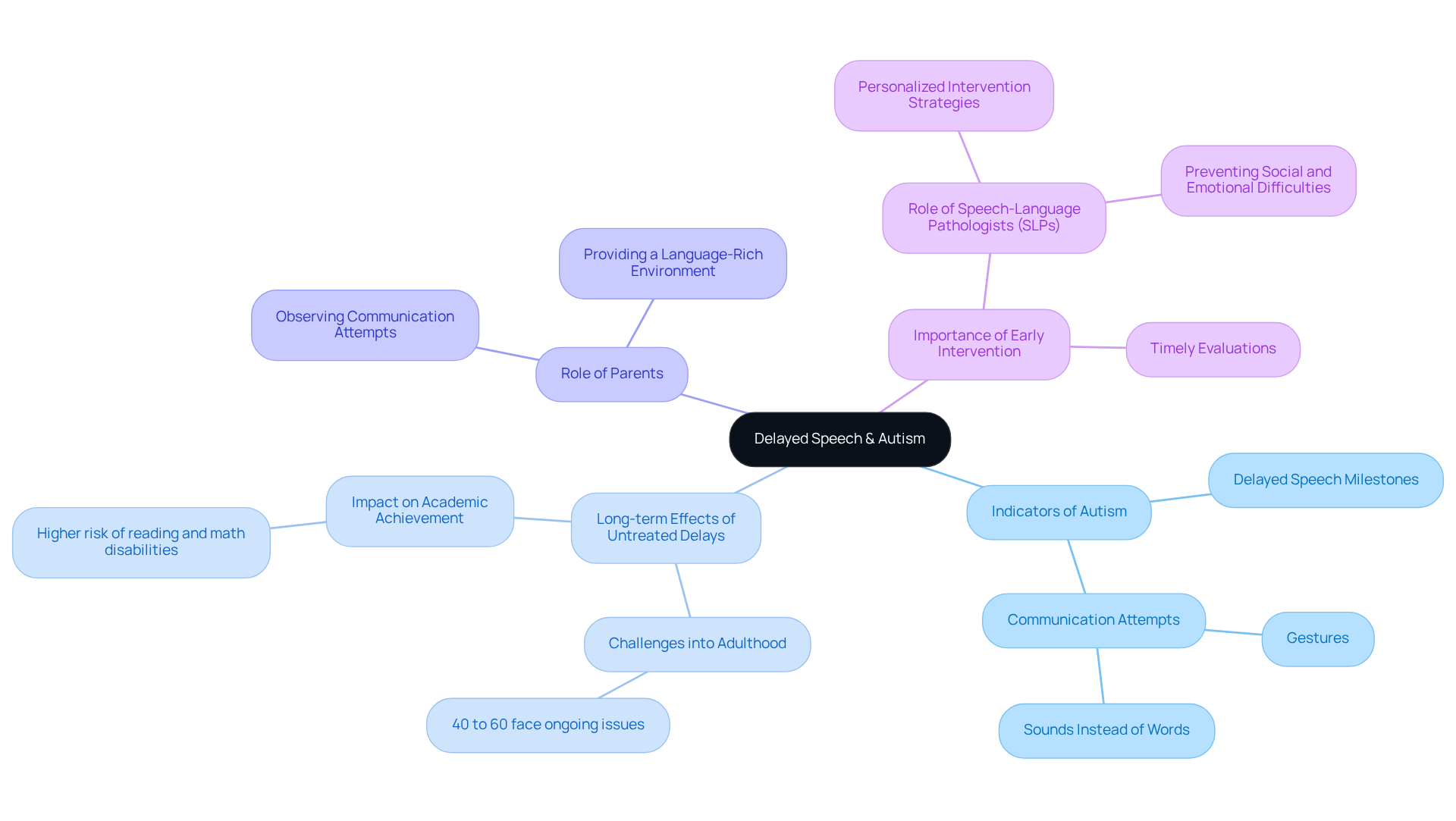
Limited Eye Contact: Understanding Social Interaction Symptoms
Restricted eye contact is a common trait among individuals with autism, often posing challenges to effective interpersonal interactions. This behavior may appear as a hesitance to make eye contact during conversations or play, which can indicate discomfort or difficulty in group settings. Research shows that the lack of eye contact typically begins in infancy and is not due to indifference or disinterest; rather, it can be a source of stress and discomfort for young children. As parents, it's important to observe your child's eye contact patterns, as these can provide valuable insights into their social engagement. Understanding this symptom is crucial for implementing targeted interventions that foster skill development.
To support your child, consider strategies such as:
- Encouraging natural eye contact
- Discussing engaging topics
- Modeling eye contact behaviors
These approaches can significantly improve communication and relationships. Effective social skills programs often incorporate these methods, including positive reinforcement and gradual exposure to eye contact, creating a nurturing environment where children can practice and enhance their social interactions.
To begin this journey, parents are encouraged to practice eye contact with familiar faces. This can help alleviate anxiety and build comfort, fostering a sense of security as your child navigates social situations.
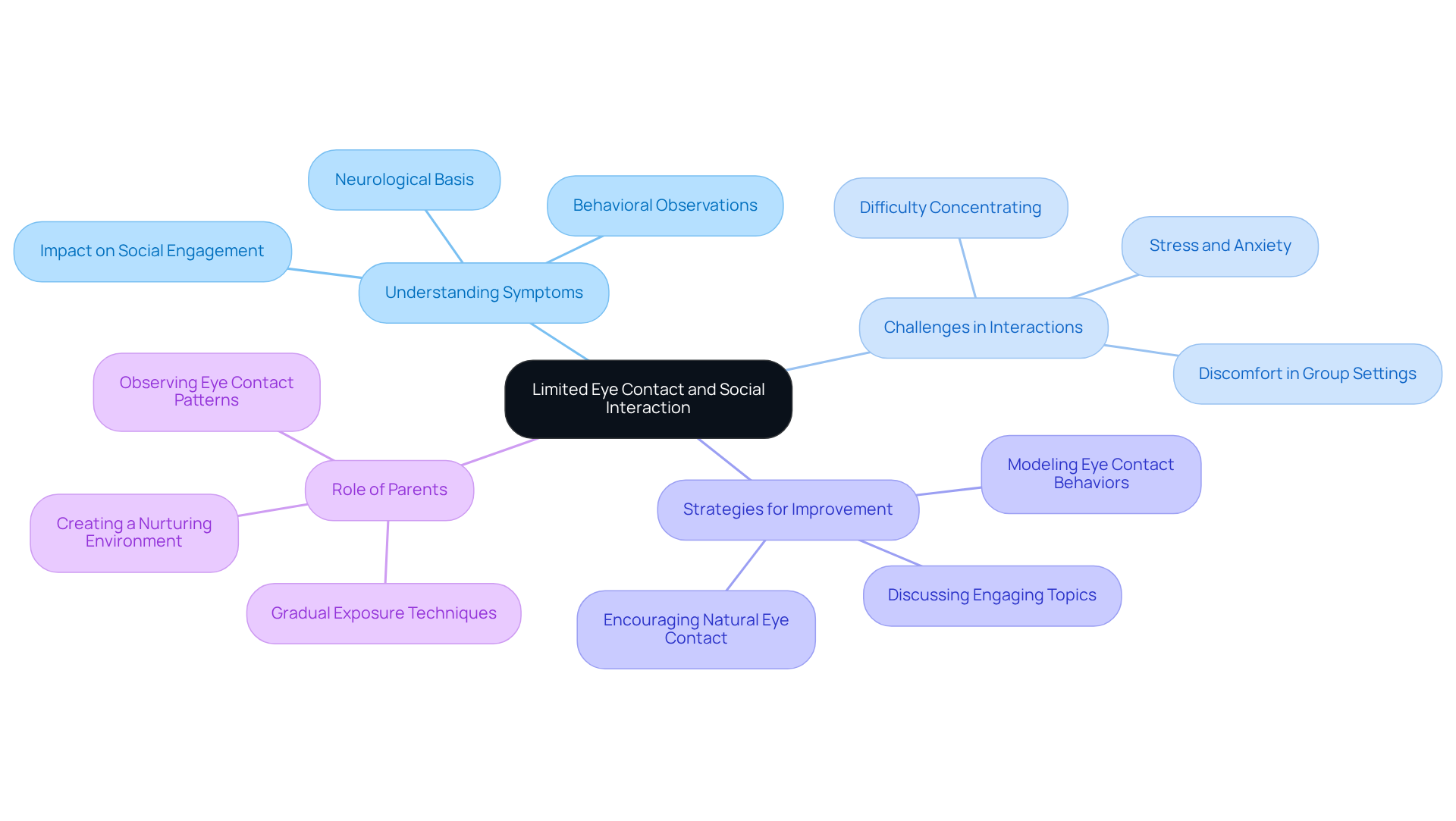
Repetitive Movements: Identifying Common Behavioral Patterns
Repetitive actions, such as hand-flapping, rocking, and spinning, are often observed in young individuals with autism, serving a crucial role in their emotional regulation. These behaviors can act as coping strategies for anxiety or sensory overload, helping children manage overwhelming sensations. As parents, it’s essential to pay close attention to the frequency and context of these movements. They can provide valuable insights into your child's emotional state.
For instance, studies indicate that approximately 69% of autistic individuals utilize stimming behaviors to alleviate anxiety. This statistic highlights the importance of recognizing these patterns. Often, environmental factors trigger the need for stimming, making it vital for caregivers to understand the context in which these behaviors occur.
By fostering an environment of acceptance and understanding around these repetitive behaviors, parents can significantly enhance their child's ability to cope with anxiety, leading to more positive outcomes. However, it's important to acknowledge that societal perceptions of stimming behaviors can become less accepting as individuals age. This shift can complicate the experiences of autistic individuals, making your support even more critical.
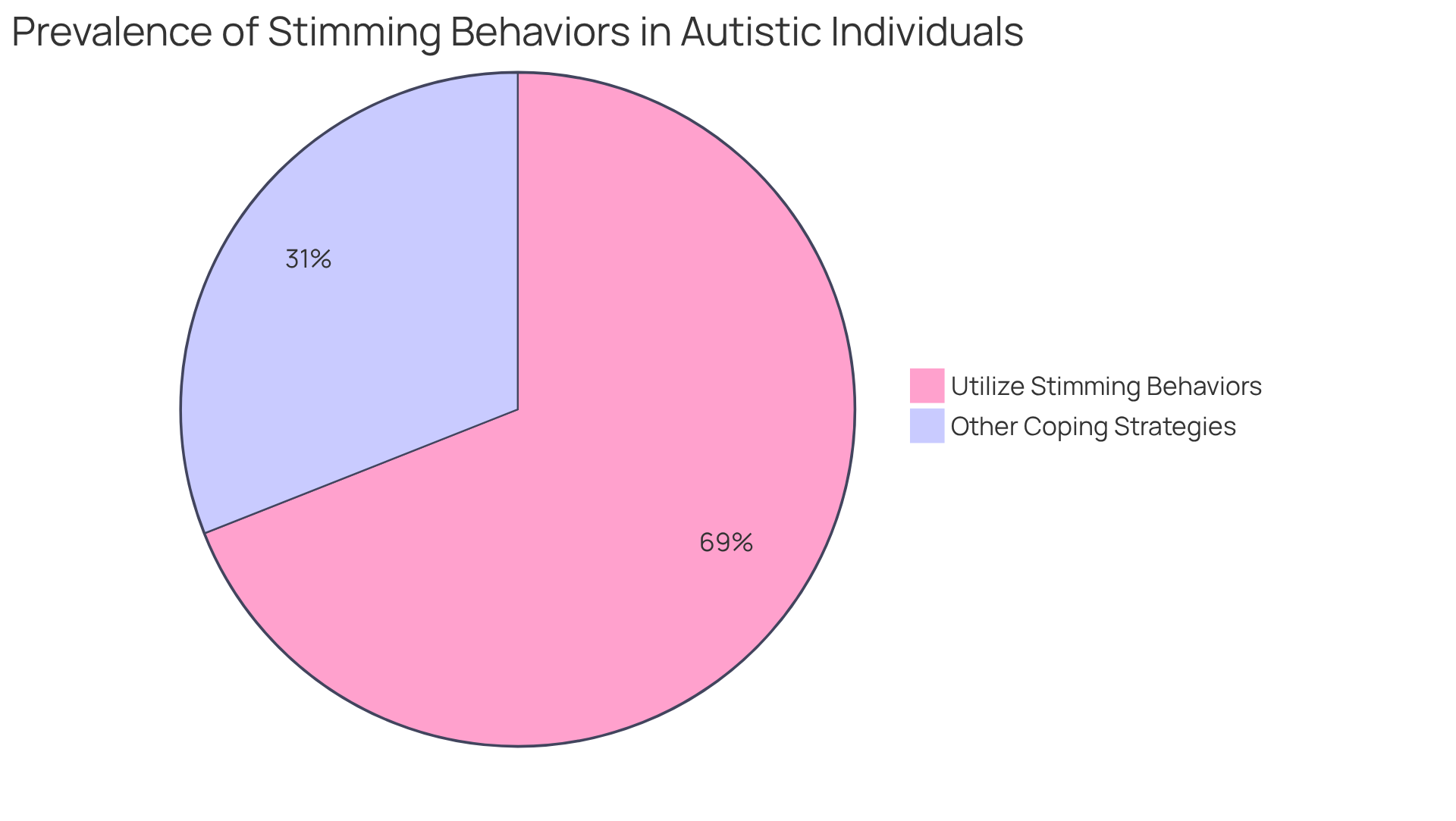
Sensory Sensitivities: Recognizing Overreactions to Stimuli
Many children with developmental disorders experience sensory sensitivities, leading to heightened reactions to sounds, lights, textures, or odors. For instance, a child might cover their ears when confronted with loud noises or refuse to wear certain fabrics. Research indicates that approximately 70-90% of individuals with autism face sensory processing challenges, highlighting the importance for caregivers to observe their children's reactions to various stimuli. By recognizing common sensory triggers, parents can make thoughtful adjustments to their environments, helping to alleviate discomfort.
Understanding these sensitivities is crucial for fostering a nurturing atmosphere that promotes comfort and security. Experts recommend designing sensory-friendly spaces that incorporate diverse textures, calming colors, and controlled lighting, which can significantly improve the daily experiences of children with sensory sensitivities. Additionally, employing sensory tools such as fidget toys and textured balls can empower children to manage their sensory needs effectively.
These proactive measures are essential in promoting comfort and facilitating better engagement in everyday activities. As you navigate this journey, consider sharing your experiences or seeking advice from others who understand the challenges, creating a supportive community for both you and your child.
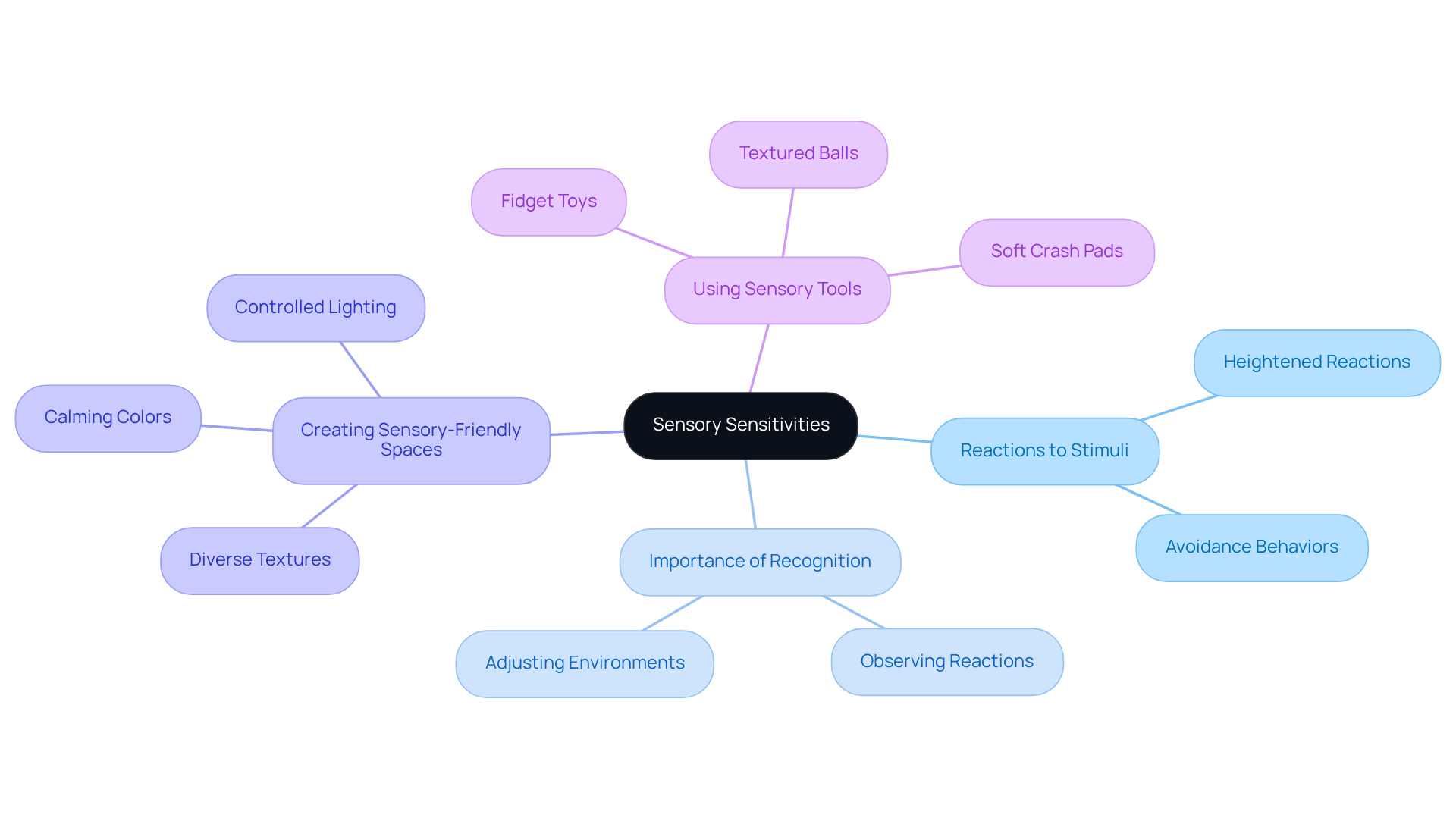
Anxiety Indicators: Recognizing Signs of Distress in Autism
Children with autism often experience a variety of anxiety symptoms, such as excessive worrying, avoidance of certain situations, and even physical signs like stomachaches. As guardians, it’s crucial to remain observant, particularly in unfamiliar or stressful environments, as these can heighten anxiety levels. You may notice common signs of distress, including:
- Changes in appetite
- Sleep disturbances
- An increase in repetitive behaviors
By recognizing these indicators, you can implement effective coping strategies. Establishing predictable routines can offer comfort, soothe the nervous system, and significantly reduce meltdowns.
Moreover, offering emotional validation is essential for nurturing resilience. It helps children feel secure and is vital for addressing their concerns. Don’t hesitate to seek professional support, which can further empower your child to manage anxiety effectively. Tailored interventions can address their unique needs, ensuring they receive the right help. Effective options might include:
- Cognitive behavioral therapy
- Mindfulness strategies
- Gradual exposure to feared situations
These approaches are designed to help young individuals navigate their emotions and experiences more successfully.
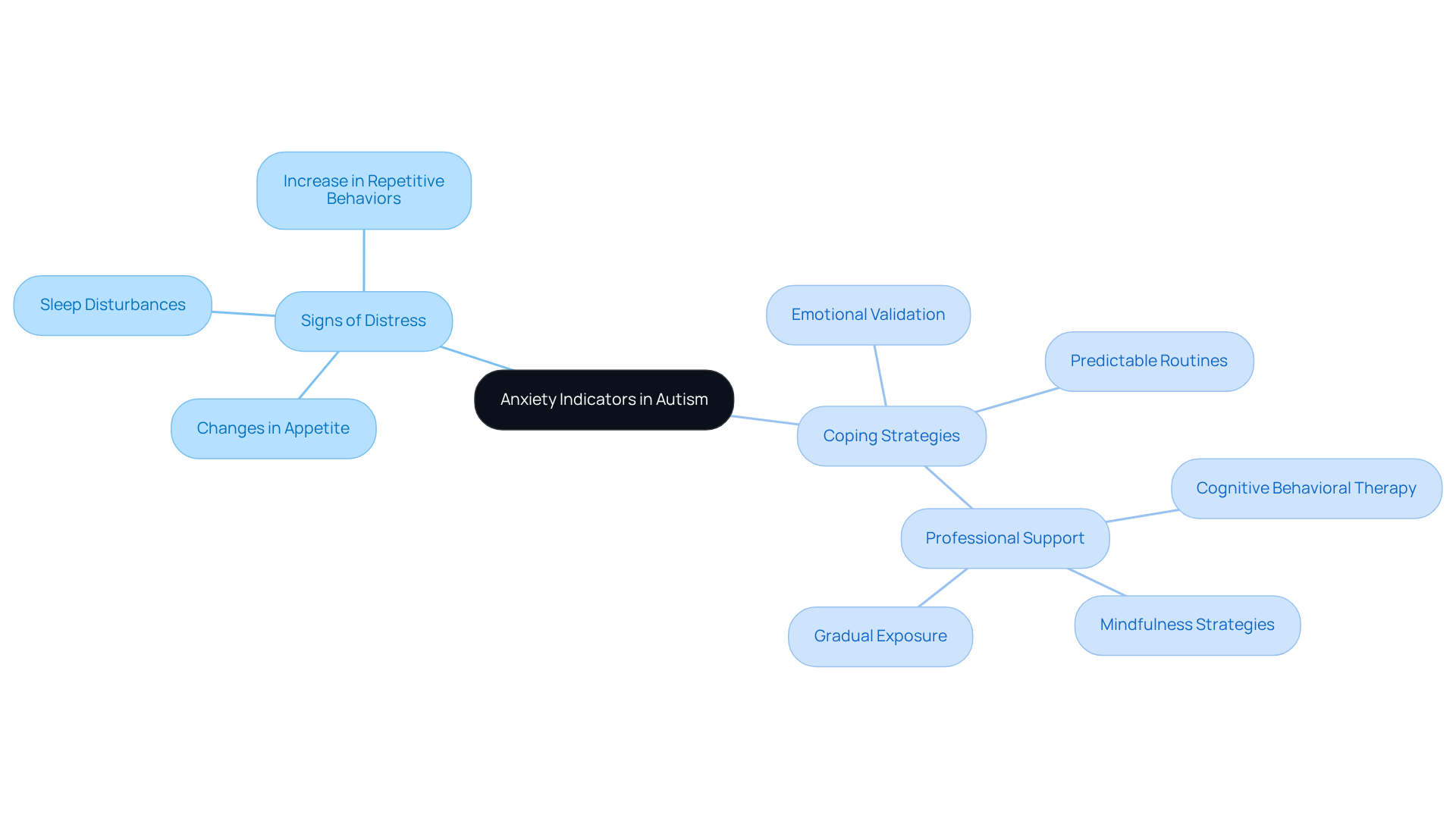
Need for Routine: Identifying Resistance to Change
Children with autism often find comfort in routine, and any disruption can lead to significant distress. This resistance to change may present itself in various ways, such as tantrums, withdrawal, or increased anxiety. To help navigate these challenges, it’s essential for guardians to establish consistent daily routines and prepare their children for upcoming changes well in advance. Predictable routines not only offer a sense of security but also help alleviate anxiety associated with unexpected transitions.
For instance, involving children in the creation of their routines can foster engagement and a sense of ownership, making them more adaptable to changes. Additionally, using visual aids can enhance comprehension and promote independence in understanding routines, supporting smoother transitions. By recognizing and addressing the need for routine, parents can cultivate a stable environment that encourages emotional regulation and improves overall behavior in their children. This journey may be challenging, but with patience and understanding, you can create a nurturing space for your child to thrive.
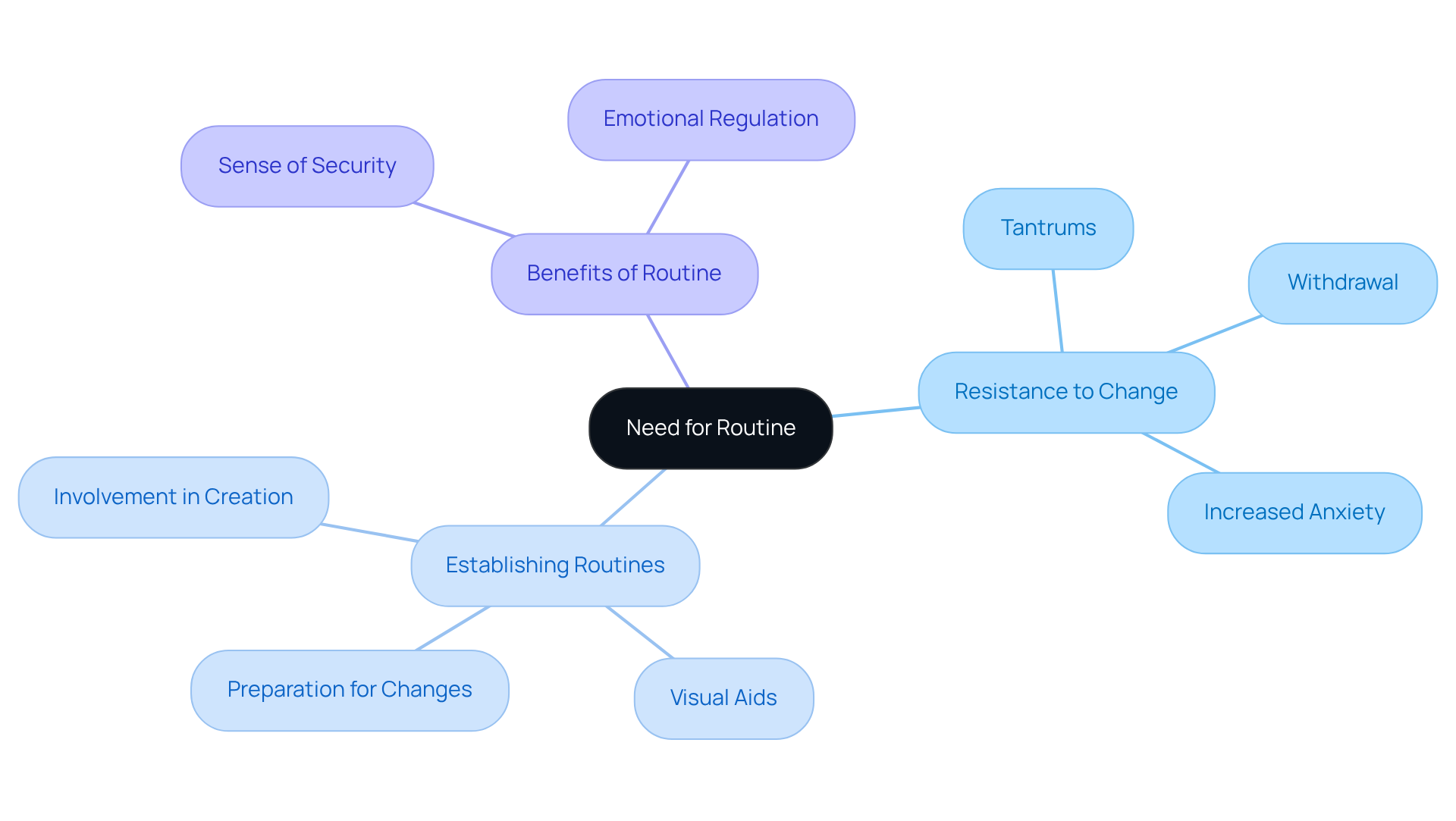
Difficulty with Non-Verbal Communication: Recognizing Key Indicators
Children with autism often encounter significant hurdles in non-verbal communication, such as interpreting facial expressions, gestures, and body language. As a caring parent, it’s essential to closely observe your child's interactions with peers. Doing so can help you identify any difficulties they may have in understanding these important social cues. Recognizing these challenges is vital, as it empowers you to implement targeted activities and interventions designed to enhance your child's interpersonal skills.
Consider effective strategies like:
- Role-playing scenarios
- Utilizing visual supports
- Engaging in structured interpersonal skills training such as Naturalistic Developmental Behavioral Interventions (NDBI), which have proven beneficial in improving communication.
Additionally, incorporating Augmentative and Alternative Communication (AAC) tools can significantly aid nonverbal individuals in expressing themselves. These approaches not only enhance communication skills but also foster stronger connections with peers, ultimately promoting a more inclusive community.
As social skills instructors emphasize, enhancing non-verbal communication abilities is crucial for young individuals with developmental disorders. It helps them navigate social interactions effectively and build meaningful relationships. It’s important to remember that approximately 25-30% of youth diagnosed with autism remain minimally verbal or nonverbal into adulthood. This underscores the long-term importance of developing these essential skills. Together, we can support our children in thriving socially and emotionally.
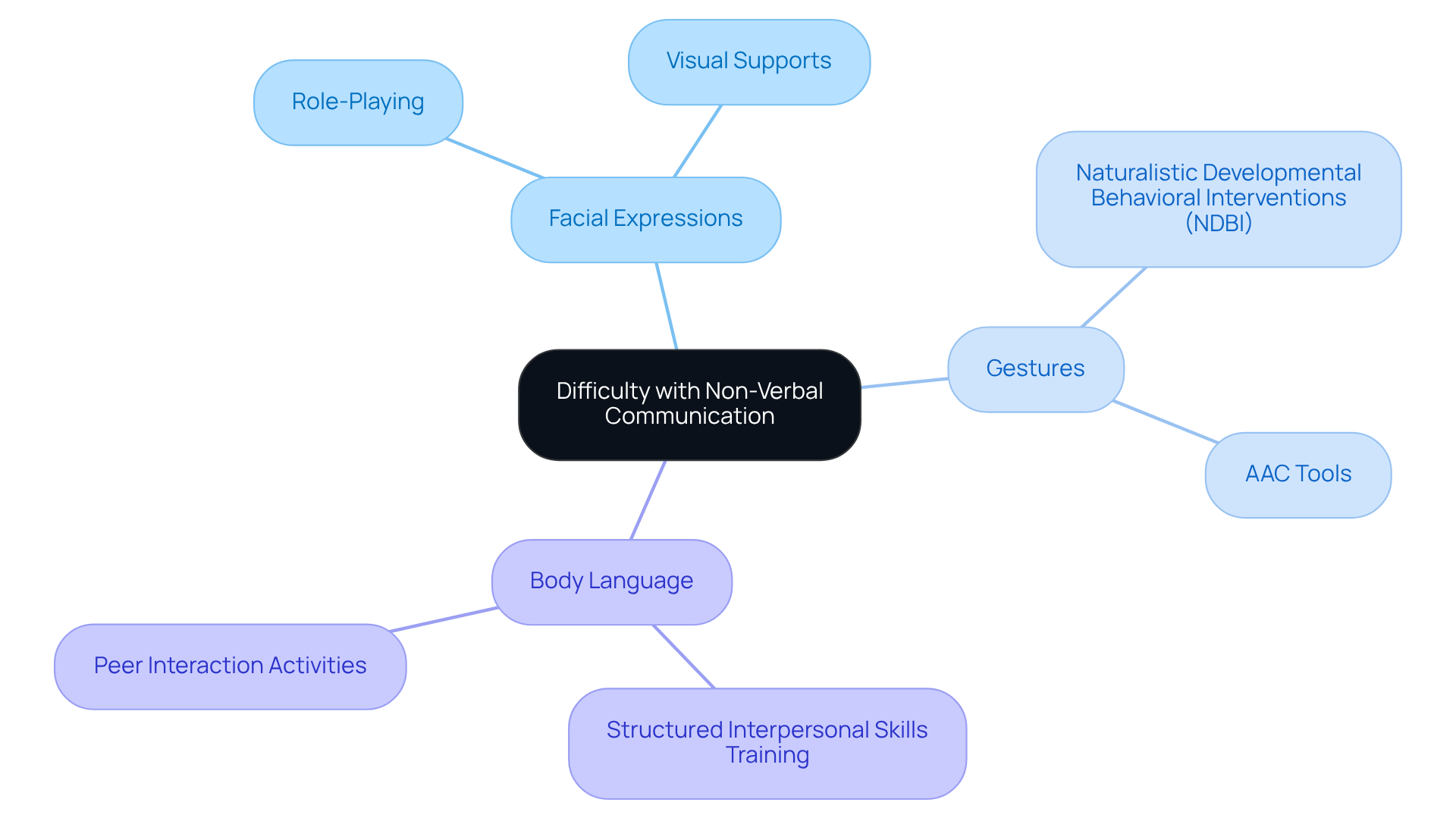
Unusual Emotional Responses: Understanding Variations in Expression
Children with autism often exhibit emotional responses that may seem atypical, such as laughing at inappropriate times or showing minimal reactions during distressing moments. For caregivers, these differences can be perplexing, highlighting the importance of considering the context of each situation when interpreting their child's feelings. By acknowledging these unique expressions, parents can better support their children in developing essential emotional regulation skills.
Successful approaches to fostering emotional awareness include:
- Using emotion cards to teach fundamental feelings
- Engaging in storytelling to enhance understanding of social cues
- Practicing relaxation techniques to manage intense emotions
Research demonstrates that nurturing emotional awareness not only facilitates smoother social interactions but also strengthens relationships and enhances overall mental health.
Experts emphasize the need for personalized strategies in teaching emotional regulation. This tailored approach ensures that young individuals with developmental differences can express themselves more clearly and engage meaningfully with others. As you navigate this journey, remember that sharing experiences and seeking support can be invaluable. What strategies have you found helpful in your own experiences? Your insights could make a difference for others in similar situations.
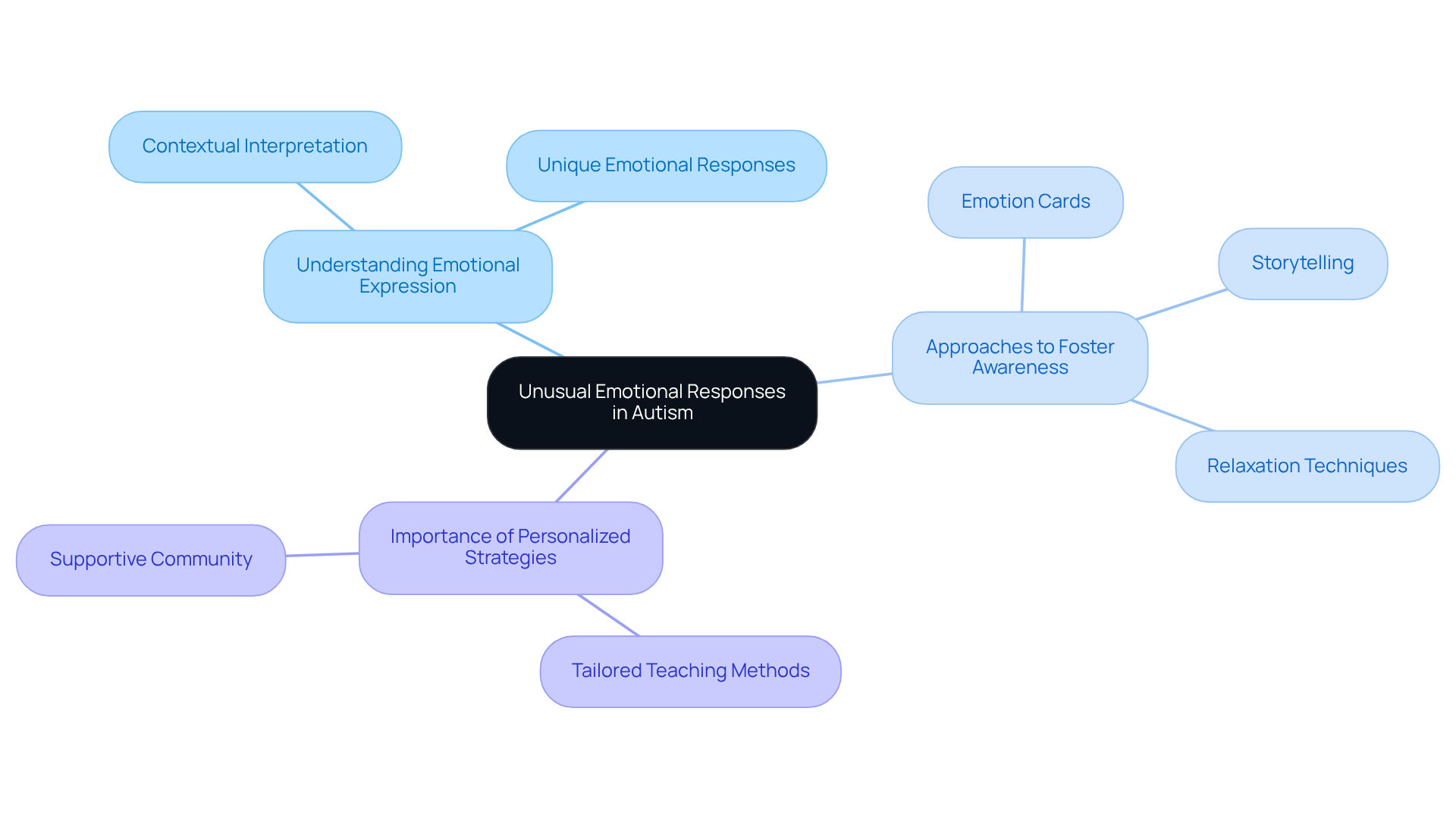
Holistic Understanding: The Importance of Recognizing Autism Symptoms
Identifying indicators of developmental disorders is a journey that requires a compassionate understanding of the various behavioral, emotional, and developmental elements unique to each child. As parents, closely observing your child's distinct characteristics and challenges is essential, as this condition manifests differently in every individual. Research shows that tailored interventions can significantly improve outcomes for young people with autism. In fact, around 40% of autistic individuals and adolescents face at least one comorbid anxiety disorder.
By recognizing the full spectrum of verbal autism symptoms, you can seek targeted support strategies that cater to your child's needs, thus creating a more inclusive and nurturing environment. It's important to understand that each child's unique characteristics are vital for effective intervention planning, ensuring they receive the personalized care they truly deserve. As of April 2025, the prevalence of autism in the U.S. stands at 1 in 31 children, highlighting the critical importance of early recognition of these symptoms. Together, we can foster understanding and support for our children, paving the way for their brighter futures.
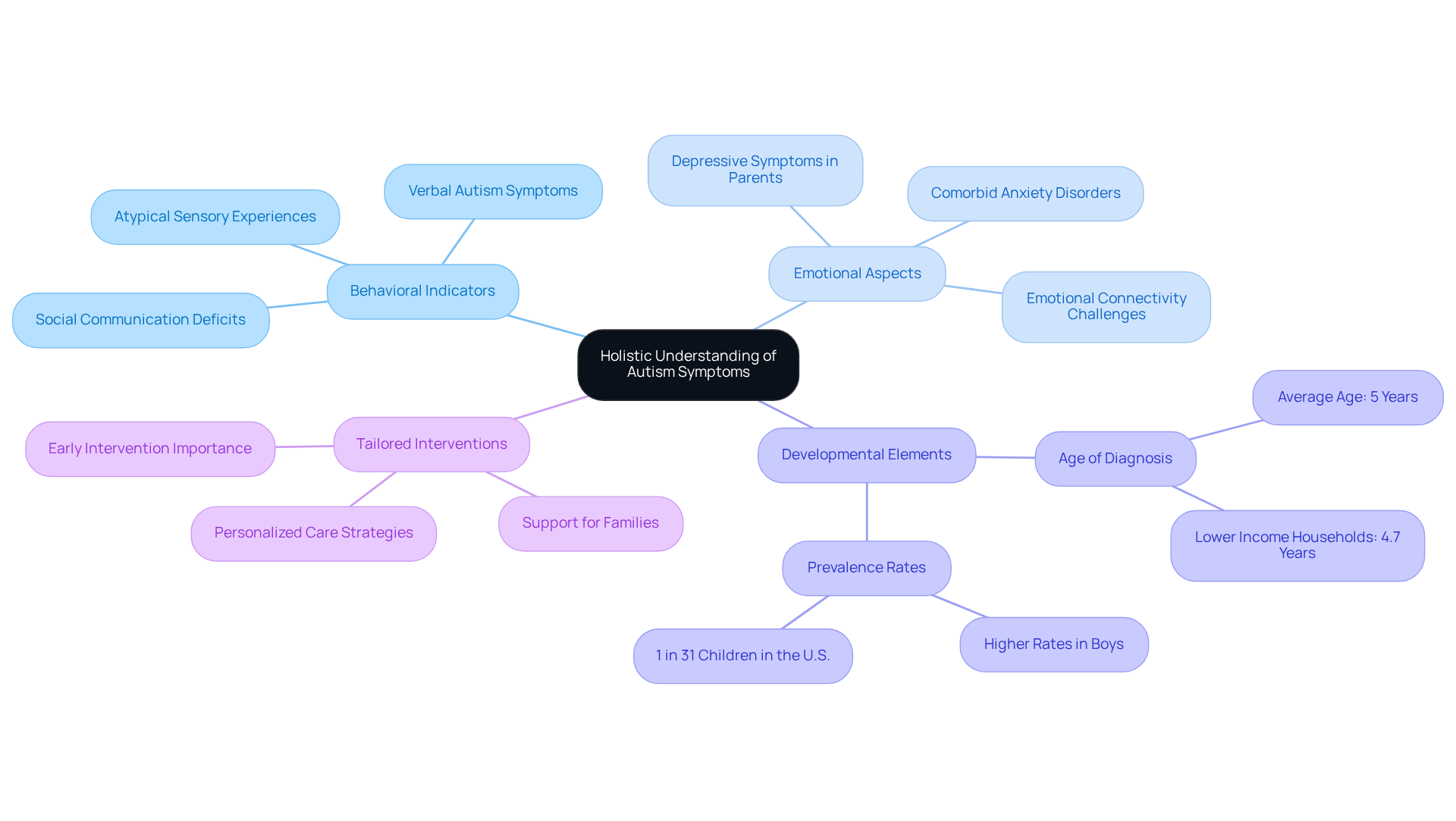
Conclusion
Recognizing verbal autism symptoms is essential for parents and caregivers striving to support their children effectively. By understanding these symptoms, such as delayed speech, limited eye contact, and sensory sensitivities, caregivers can take proactive steps toward facilitating communication and emotional regulation. Early identification and intervention are crucial in improving outcomes, highlighting the importance of awareness and education in navigating the complexities of autism.
This article has explored various verbal autism symptoms, emphasizing the need for attentive observation and tailored support strategies. From recognizing communication challenges to understanding emotional responses and the necessity of routine, each aspect plays a significant role in fostering a nurturing environment for children with autism. The insights shared here aim to empower parents with the knowledge and tools needed to address their child's unique needs.
Ultimately, fostering an inclusive and supportive community is vital for the well-being of children with autism. By sharing experiences, seeking resources, and engaging with professional support networks, parents can create a brighter future for their children. Embracing the individuality of each child and advocating for their needs not only enhances their development but also enriches the lives of those around them. Together, a compassionate approach can pave the way for understanding, acceptance, and growth in the journey of autism awareness.
Frequently Asked Questions
What is the mission of ASD Media?
ASD Media is committed to enhancing the execution of ABA therapy by providing caregivers with essential resources and insights to better understand autism and its verbal autism symptoms.
How does ASD Media support caregivers?
ASD Media offers a diverse array of materials, including informative articles, engaging webinars, and robust community support, which empower caregivers to recognize early signs of developmental disorders and share their experiences.
Why is early identification of verbal autism symptoms important?
Early identification is crucial as it significantly improves outcomes for children with developmental disorders, according to the CDC.
What role do support networks play in autism awareness?
Support networks, including professional counseling and support groups, provide vital emotional support to families and connect parents with expert insights and resources.
What is the significance of delayed speech in autism?
Delayed speech can be a significant indicator of autism, as many children may not reach their expected verbal milestones, which can lead to long-lasting challenges if unaddressed.
How can parents recognize communication challenges in their children?
Parents should observe their child's communication attempts, including gestures or sounds instead of words, as early recognition of verbal autism symptoms is essential for timely interventions.
What impact does early treatment from speech-language pathologists have?
Early treatment can be transformative, preventing further social, learning, and emotional difficulties by creating personalized intervention strategies for children with speech and language delays.
What is the importance of providing a rich language environment for children?
Insufficient stimulation can hinder language development, so offering a rich language environment is crucial for enhancing a child's ability to communicate effectively and engage socially.
What are common social interaction symptoms in individuals with autism?
Restricted eye contact is a common trait that can indicate discomfort or difficulty in group settings, often beginning in infancy and affecting interpersonal interactions.
How can parents support their child's eye contact development?
Parents can encourage natural eye contact, discuss engaging topics, and model eye contact behaviors to improve communication and relationships.
What strategies can help children practice eye contact?
Effective social skills programs often incorporate positive reinforcement and gradual exposure to eye contact, while parents can practice eye contact with familiar faces to build comfort.




